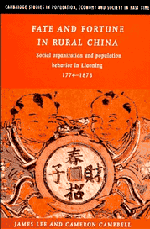Book contents
- Frontmatter
- Contents
- List of figures
- List of maps
- List of tables
- Acknowledgements
- PART 1 DAOYI VILLAGE
- PART 2 THE LIAONING DEMOGRAPHIC SYSTEM
- PART 3 HOUSEHOLD ORGANIZATION AND POPULATION BEHAVIOR
- PART 4 BANNER ORGANIZATION AND POPULATION BEHAVIOR
- 8 Bannermen and banner organization
- 9 Banner hierarchy and demographic privilege
- 10 Two types of social mobility
- EPILOGUE: PROSPECTS, IMPLICATIONS, AND COMPARISONS
- Appendices
- Glossary
- References
- Index
- Cambridge Studies in Population, Economy and Society in Past Time
8 - Bannermen and banner organization
Published online by Cambridge University Press: 20 October 2009
- Frontmatter
- Contents
- List of figures
- List of maps
- List of tables
- Acknowledgements
- PART 1 DAOYI VILLAGE
- PART 2 THE LIAONING DEMOGRAPHIC SYSTEM
- PART 3 HOUSEHOLD ORGANIZATION AND POPULATION BEHAVIOR
- PART 4 BANNER ORGANIZATION AND POPULATION BEHAVIOR
- 8 Bannermen and banner organization
- 9 Banner hierarchy and demographic privilege
- 10 Two types of social mobility
- EPILOGUE: PROSPECTS, IMPLICATIONS, AND COMPARISONS
- Appendices
- Glossary
- References
- Index
- Cambridge Studies in Population, Economy and Society in Past Time
Summary
In Daoyi, the most important organization above the level of the household was the Eight Banner system, in particular its occupational and organizational hierarchies. These overlapping hierarchies were the principal link between individuals and households on the one hand and the state on the other. The occupational hierarchy supplied the state with skilled manpower. The organizational hierarchy provided the local civil, fiscal, judicial, and military leadership, and in fact was the lowest layer of formal government administration in rural Liaoning.
The Eight Banner registers provide detailed information on the position of individuals within these two hierarchies, recording the obligations, occupations, and offices of every adult male every three years. These data are an important source not only for the study of the structure of rural social hierarchy, but also for the study of social mobility within that hierarchy. Furthermore, when combined with our knowledge of household relationships and household structure from previous chapters, they enable us to analyze the interactions between the occupational, organizational, and household hierarchies in our population.
In this chapter we describe both Eight Banner hierarchies. We do this because no similar study yet exists and because our understanding of rural banner society is consequently extremely rudimentary. In section I, we focus on the age pattern of entry to and exit from banner service, and the relationship with such life course events as marriage and headship. In sections II and III, we describe the occupational and organizational hierarchies. Finally in section IV, we provide some measures of career mobility within and between these two overlapping hierarchies.
Banner service
The basic unit of the Eight Banner occupational hierarchy in Daoyi was the adult male, or ding.
- Type
- Chapter
- Information
- Fate and Fortune in Rural ChinaSocial Organization and Population Behavior in Liaoning 1774–1873, pp. 159 - 176Publisher: Cambridge University PressPrint publication year: 1997

